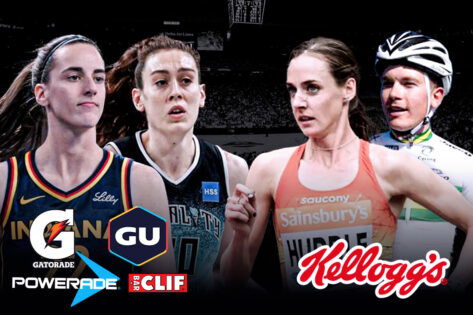In 2018, a runner in his 50s collapsed and died six miles into the Belfast Marathon. Months earlier, Matt Campbell collapsed at mile 22 of the London Marathon and never finished. Tragedies like these raise a blunt question: what pushes endurance athletes to the edge?
The answer: fuel. Marathoners, cyclists, and triathletes burn through glycogen, electrolytes, and hydration at a pace the body struggles to keep up with. Skip one, and the body can shut down. That’s why energy gels, powders, and electrolyte drinks became a lifeline for endurance athletes.
But here’s the twist: athletes are starting to swap $3 gels for $0.24 Rice Krispies Treats. The childhood snacks are suddenly nibbling at the edges of an estimated $52.32 billion sports fuel market, itself part of a $97.12 billion global nutrition market projected by 2034.
Here’s what the Krispies are doing
Kellogg’s Rice Krispies Treats are a simple snack made from sugar and processed rice.
Sugar: Digests fast for an immediate energy boost.
Processed rice: Converts to glucose to refill muscle glycogen
Quick to digest, they provide rapid energy, making them surprisingly useful for endurance athletes. But is that the whole story? Not quite.
Affordability is a significant advantage: Larger boxes cost $36.25 ($0.60 per bar), while smaller 25-count boxes are priced at $5.97 ($0.24 per bar). Compare that to traditional sports fuel:
Gels: Famous brands like GU Energy Gel, Huma Chia Gel, and Maurten Gel 100. If we look at cost, GU Energy Gel is approximately $1.58 per 32g packet.
Energy Drinks: Gatorade, Powerade, Skratch Labs, Tailwind, Nuun. For example, Gatorade (20 oz bottle) is around $2.59 per bottle.
Bars & Chews: Clif Bar, Honey Stinger. Clif Bar is typically priced at $2.09 per bar.
And now, Kellogg’s Rice Krispies Treats: A pack of 16 costs $4.89 (~$0.30 per bar). They are shelf-stable, easy to carry, and increasingly seen as a surprising option for athletes mid-race. This affordability and convenience put them up against the global sports nutrition market: gels, powders, and drinks valued at $895.40 million in 2024 and projected to reach $966.23 million by 2025 (CAGR 7.96%) according to 360iResearch. Yet Rice Krispies Treats are quietly giving strong competition.
Why athletes are replacing traditional sports fuel with simple snacks
Till now, we have understood that endurance nutrition is a billion-dollar industry. Like, energy gel sales alone are projected to nearly double from $635 million in 2024 to $1.3 billion by 2034 (Precedence Research). Brands like Maurten, GU, and Science in Sport sell gels, chews, and drinks designed for quick carbs, often promoted by icons such as marathon great Eliud Kipchoge. Each serving costs between $2 and $5.50, positioning them as premium performance fuel. Yet athletes, especially cyclists who can carry real food, have shown that solid snacks can be just as effective and sometimes gentler on the stomach. Here’s how:
Engineered nutrition (sports gels, powders, bars) is specifically designed in labs to give athletes energy, electrolytes, and recovery support. But many athletes feel it’s over-engineered, expensive, and sometimes tough on the stomach.
Simple carbs, such as Rice Krispies Treats, provide the same fast-digesting glucose in a more natural, familiar, and affordable way. They’re quick energy sources without the artificial flavors and chemicals.
Athletes are starting to prefer whole foods or simple snacks because they are easier to eat, digest, and taste better, while still refueling muscles during long workouts.
This debate is exactly why Rice Krispies Treats have suddenly become popular among runners, cyclists, and gym-goers. They’re a “simple carb hack” now competing with expensive engineered sports fuels. But do we have real examples?
Pros are choosing Rice Krispies over engineered fuels
Molly Huddle, a professional marathoner and two-time Olympian, said: “I wanted something that I liked eating, so it wasn’t a chore, and something that wasn’t going to set off my gut the next day. Any rice-based food, I noticed, always sat really well with me. Put a little sugar on the rice, and there you go,” she told Front Office Sports. She isn’t alone.
Hobbs Kessler, a middle-distance runner and Paris Olympian, keeps them in his car for post-workout snacks. Even Nick Schultz, a pro cyclist, admits he eats them almost every day in training and competition. “On race days, I’ll almost certainly snack on one or two between breakfast and the race start time, along with filling my pockets with at least four squares to go with gels, bars, and drink mix,” he said. And that’s where the tension builds.
The global sports nutrition market was worth $47.45 billion in 2024 and is projected to almost double to $97.12 billion by 2034 (CAGR 7.4%). Yet athletes reaching for a $0.30 Rice Krispies bar raise a provocative question: could a humble snack chip away at a $97 billion projected industry? The threat isn’t just possible, it’s already happening.
Here’s how the shift is happening:
Cheap, accessible, quick-energy snacks could cut into sales of $2-$5 engineered fuels
If simple carbs work just as well, why pay more for “optimized” products?
Athletes want cleaner, minimally processed foods.
It looks like “junk food” might be sneaking into sports fueling. As we saw, Rice Krispies Treats give athletes quick carbs in a cheaper, tastier way than gels or drinks. Sure, they lack electrolytes or protein, so balance is still necessary, while energy gels and drinks are specially formulated with carb blends, electrolytes, and sometimes caffeine to optimize performance, hydration, and absorption. Maybe it’s not about replacing sports nutrition, but rethinking it with snacks we already love.
Can ‘junk food’ really fuel the future of endurance sports? Maybe not replace the $52.32 billion sports fuel market, but it’s already carving out a niche as the cheaper, tastier, and surprisingly effective alternative.
The post The $0.30 Snack Disrupting the $52 Billion Sports Fuel Market appeared first on EssentiallySports.
